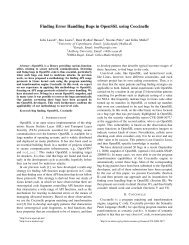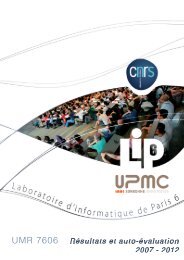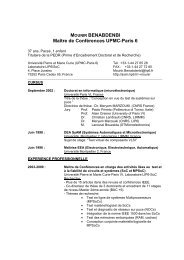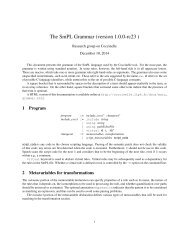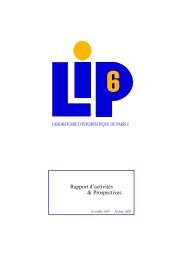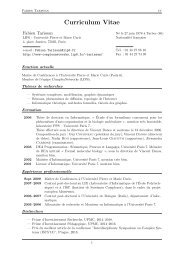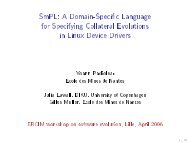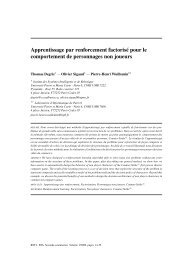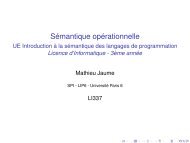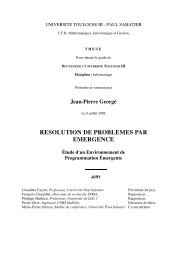Proceedings [PDF] - Measurement and Analysis of P2P Activity ...
Proceedings [PDF] - Measurement and Analysis of P2P Activity ...
Proceedings [PDF] - Measurement and Analysis of P2P Activity ...
You also want an ePaper? Increase the reach of your titles
YUMPU automatically turns print PDFs into web optimized ePapers that Google loves.
International Conference Advances in the <strong>Analysis</strong> <strong>of</strong> Online Paedophile <strong>Activity</strong> Paris, France; 2-3 June, 2009<br />
relies upon the use <strong>of</strong> well-known files. Hence, it is incapable <strong>of</strong> identifying those <strong>of</strong>fenders<br />
who may be sharing recently-produced material. The incorporation <strong>of</strong> monitoring<br />
functionality in file sharing systems requires significantly altering multiple components to<br />
ensure that monitoring takes place at the right points in the system. However, such invasive<br />
changes are expensive <strong>and</strong> hard to maintain <strong>and</strong> evolve across various releases <strong>of</strong> a system.<br />
The recent rise <strong>of</strong> aspect-oriented s<strong>of</strong>tware development techniques [4] has facilitated noninvasive<br />
composition <strong>of</strong> such systemic concerns as monitoring, which makes in-step<br />
evolution <strong>of</strong> such functionality with changes in the rest <strong>of</strong> the system more modular <strong>and</strong><br />
manageable. Though aspect-oriented techniques have been used in individual systems (e.g.,<br />
the widely used mysql database system) for logging purposes, to date, they have neither been<br />
applied for monitoring online social networks nor on a scale spanning multiple systems <strong>and</strong><br />
various releases <strong>of</strong> such systems. A particular issue in file sharing systems is that filenames<br />
reflect specialised vocabulary which changes over time [11].<br />
Taking an ethical perspective on this research is not only important in respect <strong>of</strong> the abuse <strong>of</strong><br />
children [12], <strong>and</strong> the protection <strong>of</strong> the researchers who conduct this type <strong>of</strong> research, but also<br />
because <strong>of</strong> the issues surrounding the use <strong>of</strong> monitoring technologies that have an impact on<br />
user privacy [13]. Researchers in the field <strong>of</strong> computer ethics have noted that values are<br />
embedded within technology design, e.g., [14, 15], <strong>and</strong>, as a result, there have been numerous<br />
calls for the integration <strong>of</strong> ethical assessment, evaluation <strong>and</strong> stakeholder impact analysis<br />
within the design <strong>and</strong> development <strong>of</strong> computer systems to mitigate adverse effects, e.g., [16,<br />
17]. In advocating this approach there is a recognition that not only are the potential risks<br />
associated with the s<strong>of</strong>tware development reduced [18], but also that the awareness <strong>of</strong> the<br />
development team to the ethical aspects inherent in these systems is raised – thus creating a<br />
body <strong>of</strong> ‘ethically aware’ information pr<strong>of</strong>essionals [6]. To date there has been a lack <strong>of</strong><br />
suitable case studies in the computer ethics literature <strong>and</strong> appropriate guidance for technology<br />
developers to incorporate ethical considerations within the development cycle. This project is<br />
developing new underst<strong>and</strong>ings <strong>of</strong> user-centred methods for highly sensitive systems <strong>and</strong> <strong>of</strong><br />
effective designs <strong>of</strong> privacy/awareness interfaces that will benefit other developments <strong>and</strong><br />
mitigate the effects <strong>of</strong> adverse outcomes that impact on public acceptability.<br />
References<br />
[1] T. Byron, “Safer children in a digital world: the report <strong>of</strong> the Byron review”,<br />
http://www.dcsf.gov.uk/byronreview/, 2008.<br />
[2] J. Palfrey, “Enhancing child safety & online technologies: final report <strong>of</strong> the Internet<br />
safety technical task force”, Berkman Center, Havard University, 2008.<br />
[3] D. Hughes, S. Gibson, J. Walkerdine, G. Coulson, “Is deviant behaviour the norm on <strong>P2P</strong><br />
file sharing networks” IEEE Distributed Systems Online 7(2), 2006.<br />
[4] R. Filman, T. Elrad, S. Clarke, M. Aksit (eds.), “Aspect-Oriented S<strong>of</strong>tware<br />
Development”, Addison-Wesley, 2001<br />
[5] D. Hughes, J. Walkerdine, K. Lee, “Monitoring challenges <strong>and</strong> approaches for <strong>P2P</strong> file<br />
sharing systems”, Proc. 1st International Conference on Internet Surveillance <strong>and</strong><br />
Protection (ICISP’06), 2006.<br />
[6] M. Taylor, E. Quayle. “The Internet <strong>and</strong> Abuse Images <strong>of</strong> Children: Search, Pre-criminal<br />
Situations <strong>and</strong> Opportunity” Situational Prevention <strong>of</strong> Child Sexual Abuse, R. Wortley, S.<br />
Smallbone (eds.), Criminal Justice Press, 2006. pp. 169-195.<br />
[7] S. Dombrowski, K. Gischlar, T. Durst, “Safeguarding young people from cyber<br />
pornography <strong>and</strong> cyber sexual predation: a major dilemma <strong>of</strong> the Internet”. Child Abuse<br />
Review 16, 2007, pp. 153-170.<br />
[8] D. Finkelhor, K. Mitchell, J. Wolak, “Online Victimization: A Report on the Nation’s<br />
Youth”, National Center for Missing <strong>and</strong> Exploited Children, Alex<strong>and</strong>ria, VA, 2000.<br />
[9] P. Rayson (2008). From key words to key semantic domains. International Journal <strong>of</strong><br />
Corpus Linguistics. 13:4 pp. 519-549.<br />
36


![Proceedings [PDF] - Measurement and Analysis of P2P Activity ...](https://img.yumpu.com/32964521/36/500x640/proceedings-pdf-measurement-and-analysis-of-p2p-activity-.jpg)

